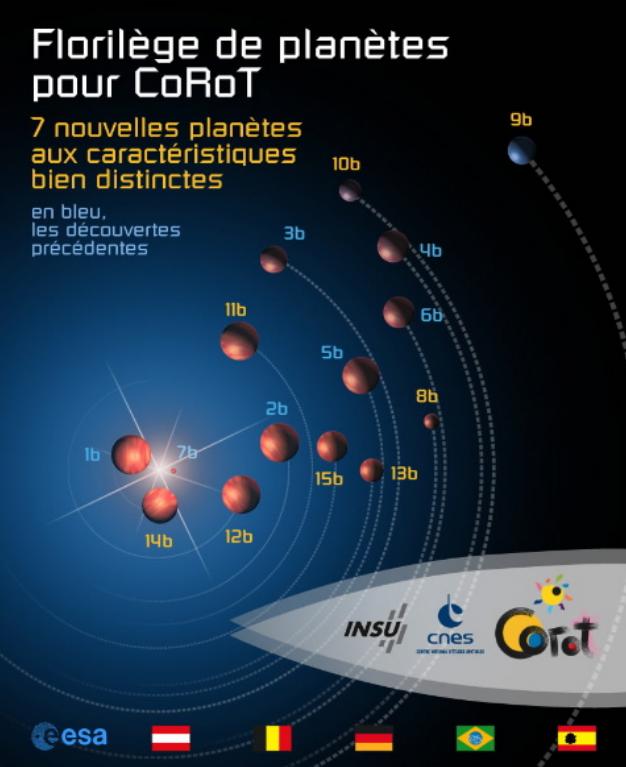Among the 430 exoplanets detected to date, more than 70 have the good fortune to transit the stellar disk of their parent star. The particular interest of these transiting planets is that during the transit their atmosphere blocks the spectral lines of present molecules. This circumstance allows to detect these molecules and assess their abundance. Until now, all transiting planets were sitting at a short distance of their star (at least for a part of their orbit), making them hot planets with temperatures well above 1000 K. That is why they are called "hot Jupiters" (or, for the smallest ones hot super-Earths).

What is new with CoRoT-9b is its large orbital period of 95 days, implying a distance of 0.4 AU from its parent star, similar to the Mercury distance to the Sun. Given the star luminosity, it results an equilibrium temperature of the planet heated by the star between -20 and +160 degrees Celsius, depending of the efficiency of the absorption of the stellar flux and of the greenhouse effect. This temperature places CoRoT-9b as the coldest transiting planet yet discovered. If by any chance this planet would have an Earth-like "moon", the later could be in the habitable zone of the star (where water can be liquid). In addition, being at a distance of 0.4 AU from the star, it is not affected by tidal forces which would otherwise lead to internal heating. This makes modelling of the planet easier.
With CoRoT-9 b we enter a new domain of planet "meteorology". It is not the first time that "temperate" Jupiters are detected (several tens are known from detection by the radial velocity method), but it is the first time that a transiting temperate Jupiter is detected. With this discovery it will be possible to investigate it by "transmission spectroscopy" in a temperature regime up to now unexplored. These studies can in a near future be done with the European Very Large Telescope in Chile or from space with for instance the ESA/NASA James Web Space Telescope. These observations will allow to investigate for example how the "chemical equilibrium" in the planet atmosphere (i.e. for instance the carbon dioxide to methane ratio) depend on the planet temperature and to detect molecules stable at the CoRoT-9b temperature but unstable in hot Jupiter planets.
With this new temperature regime, and thanks to a few previous transiting planets, comparative planetology broadens again and we will certainly have new surprises. We are ready for new interesting observations in the very next coming years with, on the european side, the Sphere Camera at the Very Large Telescope in Chile and the future ESO Extremely Large Telescope on the ground, the ESA Gaia mission and the MIRI Camera at the ESA/NASA James Web Space Telescope in space. The Paris Observatory is present in the realization and future exploitation of all these four facilities.
Note 1 : The total observing time of CoRoT for this star has been 140 days. With an orbital period of 95 days for CoRoT-9b, the satellite has only observed 2 transits of the planet
Know more
Reference
- H.J. Deeg, C. Moutou, A. Erikson, Sz. Csizmadia, B. Tingley, P. Barge, H. Bruntt, M. Havel, S. Aigrain, J.M. Almenara, R. Alonso, M. Auvergne, A. Baglin, M. Barbieri, W. Benz, A. S. Bonomo, P. Bordé, F. Bouchy, J. Cabrera, L. Carone, S. Carpano, M. Deleuil, R. Dvorak, S. Ferraz-Mello, M. Fridlund, D. Gandolfi, J.-C. Gazzano, M. Gillon, P. Gondoin, E. Guenther, T. Guillot, R. den Hartog, A. Hatzes, M. Hidas, G. Hébrard, L. Jorda, P. Kabath, H. Lammer, A. Léger, T. Lister, A. Llebaria, C. Lovis, M. Mayor, T. Mazeh, M. Ollivier, M. Pätzold, F. Pepe, F. Pont, D. Queloz, M. Rabus, H. Rauer, D. Rouan, J. Schneider, A. Shporer, B. Stecklum, R. Street, S. Udry, J. Weingrill et G. Wuchterl A transiting giant planet with a temperature between 250 K and 430 K Nature, Mars 2010 Participating Institutions : Observatoire de Paris (LESIA et LUTh, CNRS, UPMC, Univ Paris-Diderot), Instituto de Astrofisica de Canarias, Laboratoire d’Astrophysique de Marseille, German Aerospace Center, U. of Exeter, Observatoire de Genève, Universität Bern, IAS Orsay, IAP, Universitä zu Köln, ESA/ESTEC, University of Vienna, Universidade de Sao Paulo, Thüringer Landessternwarte, University of Liège, OCA, Las Cumbres Observatory, Space Research Institute Graz, Tel Aviv University, University of Sydney, Universita di Padova, OHP, Oxford Astrophysics et CalTech.
